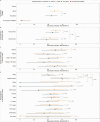Household Transmission of Severe Acute Respiratory Syndrome Coronavirus 2 (SARS-CoV-2) Alpha Variant-United States, 2021
- PMID: 35147176
- PMCID: PMC9047162
- DOI: 10.1093/cid/ciac125
Household Transmission of Severe Acute Respiratory Syndrome Coronavirus 2 (SARS-CoV-2) Alpha Variant-United States, 2021
Abstract
Background: In Spring 2021, severe acute respiratory syndrome coronavirus 2 (SARS-CoV-2) B.1.1.7 (Alpha) became the predominant variant in the United States. Research suggests that Alpha has increased transmissibility compared with non-Alpha lineages. We estimated household secondary infection risk (SIR), assessed characteristics associated with transmission, and compared symptoms of persons with Alpha and non-Alpha infections.
Methods: We followed households with SARS-CoV-2 infection for 2 weeks in San Diego County and metropolitan Denver, January to April 2021. We collected epidemiologic information and biospecimens for serology, reverse transcription-polymerase chain reaction (RT-PCR), and whole-genome sequencing. We stratified SIR and symptoms by lineage and identified characteristics associated with transmission using generalized estimating equations.
Results: We investigated 127 households with 322 household contacts; 72 households (56.7%) had member(s) with secondary infections. SIRs were not significantly higher for Alpha (61.0% [95% confidence interval, 52.4-69.0%]) than non-Alpha (55.6% [44.7-65.9%], P = .49). In households with Alpha, persons who identified as Asian or Hispanic/Latino had significantly higher SIRs than those who identified as White (P = .01 and .03, respectively). Close contact (eg, kissing, hugging) with primary cases was associated with increased transmission for all lineages. Persons with Alpha infection were more likely to report constitutional symptoms than persons with non-Alpha (86.9% vs 76.8%, P = .05).
Conclusions: Household SIRs were similar for Alpha and non-Alpha. Comparable SIRs may be due to saturation of transmission risk in households due to extensive close contact, or true lack of difference in transmission rates. Avoiding close contact within households may reduce SARS-CoV-2 transmission for all lineages among household members.
Keywords: Alpha; COVID-19; SARS-CoV-2; household; transmission.
Published by Oxford University Press for the Infectious Diseases Society of America 2022.
Figures


References
-
- Volz E, Mishra S, Chand M, et al. Assessing transmissibility of SARS-CoV-2 lineage B.1.1.7 in England. Nature 2021; 593:266–9. - PubMed

